FAQ
Passenger with Disabilities
Barrier-Free Accommodations
Barrier-free cabins are available on the M/Vs COLUMBIA, MALASPINA, MATANUSKA, TAKU and TUSTUMENA. Arrangements for special cabins to accommodate wheelchairs may be made through our reservations office. You must be 80% confined to a wheelchair to qualify. It is the policy of the Alaska Marine Highway System that no qualified individual with a disability shall, on the basis of disability, be excluded from participation, or be denied the benefits of the services, programs, or activities of the System, or be subjected to discrimination by any employee of the System.
It is the passenger's responsibility to notify the Alaska Marine Highway System if special accommodations will be needed in the event of an emergency. Please make these special needs known when making reservations, and notify the purser upon boarding the vessel. Special barrier-free vans may be available for assistance from shore to the vessel's car-deck.
Elevators
Elevator access is available on all vessels.
Most vessels have a special van for transporting passengers confined to wheelchairs to and from the Terminal to the car deck and Elevator. Arrangements for using the vans should be made at the time of booking.
Border Information
U.S. Citizens
If you reside in the U.S. and will be traveling through Canada in connection with your Alaskan trip you need a passport to re-enter the USA.
Native-born citizens of all ages should carry a birth certificate together with photo identification and passports. Driver’s licenses alone are not proof of citizenship.
Foreign visitors and residents
Foreign visitors to the U.S. or Canada should be aware of the visa requirements pertaining to your home country. Should you have any doubt, feel free to e-mail us with particulars describing your situation.
U.S. residents who are not citizens should carry their Alien Registration Card.
Permanent residents of Canada who are not Canadian citizens should have their Landed Immigrant Visa.
All Travelers
Canada Customs officials will require travelers to show proof of sufficient funds for the trip. Motorists may be asked to show their vehicle registration card or proof of title and liability insurance coverage.
If you are a parent traveling with a child and without the other parent, you may be asked to show a notarized document from the other parent consenting for the child to be taken out of the country.
Customs Contacts and Hours
Haines Highway at Pleasant Camp
U.S. Customs: 907-767-5511
Canada Customs: 907-767-5540
Hours: 7:00 AM – 11:00 PM Alaska Time
Through traffic is prohibited when the border is closed.
Prince Rupert and Ketchikan ferry arrival and departures
U.S. Customs: 250-624-5351
Canada Customs: 250-627-3003
Hours: 8:00 AM – 5:00 PM
Passengers proceeding into the USA from Prince Rupert will be inspected by US Customs in Rupert prior to departure.
Skagway/Frazier/Whitehorse/Yukon Territory Road
U.S. Customs: 907-983-2325
Canada Customs: 867-821-4111
Hours: 7:00 AM - 11:00 PM
U.S. Customs Website: http://www.cbp.gov/
Canada Customs Website: http://www.cbsa-asfc.gc.ca/menu-eng.html
Border crossing hours and policies are subject to change at any time. Call ahead if you are planning on a border crossing at odd hours or have specific questions as to duty-free allowances.
Frequently Asked Questions / General Sailing Information
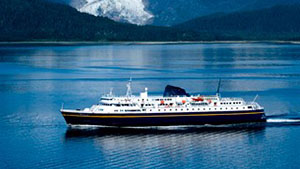
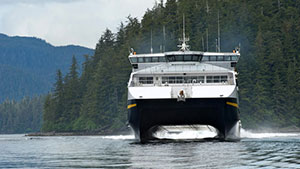
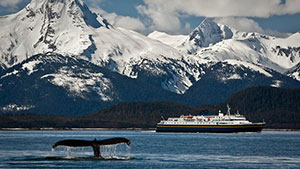
The Alaska Ferry is a great way to see SE Alaska, as there are many areas that can only be seen by water and the ferry does make stops along the way allowing you to see the different towns. However, the ferry routes are classified as a highway, thus the stops are typically anywhere from a half hour to three hours depending on whether the ferry is on schedule and the low tides that affect the passages. When the ferry is in port they will announce whether you have some time to stretch your legs and explore the town or if they would like you to not leave the terminal. To get the best of both worlds many choose to “island hop” between the towns they would like to spend time in.
Boarding
Passenger check-in is two hours prior to departure in Bellingham and one hour elsewhere.
Vehicle check-in times range from one to three hours prior to departure depending on the terminal you are departing from. For security reasons you are only allowed to return to your vehicle when the ferry is in port or during car deck call times, so take what you want with you to the passenger decks!
- Bellingham and Prince Rupert: 3 hours
- Skagway, Haines, Juneau, and Ketchikan: 2 hours
- Petersburg 1.5 hours
- Homer, Whittier and Kodiak: 2 hours (Except Whittier Cross-Gulf sailings: 3 hours
- Sitka: Call 907.747.8737 one hour before the arrival time listed in the schedule
- All other ports: 1 hour
Lengthy check-in times are needed so that the vehicles can be arranged in the boarding lanes for safe and efficient loading. Passengers with vehicles who do not arrive on time may find that their reserved space has been given to someone waiting on the standby list.
Transporting Firearms
Walk-on passengers traveling on the Alaska Ferry system with legal firearms or weapons are required to check these items with vessel personnel. All firearms must be unloaded and ammunition stowed separately from the firearms. Unloaded firearms may be securely locked in a passenger's vehicle.
Concealed weapons are not allowed on any vessels. Handguns are only permitted in Canada by specific application and RCMP approval for EACH Canadian Providence. This must be done well before visiting Canada.
You are NOT permitted to carry hand weapons to or through Canada without permit. Any person arriving at a Canadian port of entry with a restricted weapon will be required to return the weapon to the United States. Canadian Customs will not hold weapons pending your return to the U.S.
Failure to declare possession of a restricted weapon will result in seizure of the weapon, possibly your vehicle and prosecution.
If you have any additional questions about bringing a firearm into Canada, we suggest that you contact the Canadian Firearms Centre at 1-800-732-4000 or (506)-624-5380. They can be reached by email at cfc-cafc@cfc-cafc-gc.ca and their website is http://www.rcmp-grc.gc.ca/cfp-pcaf/form-formulaire/index-eng.htm#f6.
Additional restrictions: non-U.S. citizens arriving into the U.S. with firearms must obtain a permit from the Department of Justice. Approval could take up to six weeks. ATF&E Website
Check with Customs in the U.S. or Canada before attempting to enter either country with a weapon.
Carrying Hazardous Materials
Explosive, highly flammable materials, corrosives, etc. may not be transported on the Marine Highway. Bottled gas containers, such as those used by recreation vehicles, must be turned off and sealed by a Marine Highway employee before being transported. Small portable containers of fuel (5 gallons or less, limited to 2 containers) are permitted but must be properly sealed, labeled with your name for identification, and turned over to vessel personnel for proper storage while en-route.
Bicycles, Kayaks, or Inflatables
Bicycles, kayaks, and very small boats (under 100 lbs), will be charged at the "Alternate Means of Conveyance" rate. If the boat exceeds 100 pounds, it will be charged at the "Vehicles to 10 feet" rate. Larger boats must be on a trailer and will be charged the appropriate vehicle rate by length.
Baggage
Foot passengers may bring hand luggage only, with weight up to 100 pounds total. To help passengers get their hand luggage on board, baggage carts are driven from the terminal to the car deck. No baggage carts are available on the M/V TUSTUMENA.
Passengers are responsible for the handling and safety of their luggage. Baggage handling is not provided and the State is not responsible for lost, stolen or damaged baggage. There is no weight limit on luggage carried in or on a vehicle.
Coin-operated storage lockers are available aboard the M/Vs Columbia, Kennicott, Matanuska, Taku, and Tustumena for storage of smaller items.
Unaccompanied baggage is not allowed on board Alaska Ferry vessels. It is considered freight by the U.S. Coast Guard and must be shipped via commercial carrier or U.S. mail.
Sleeping
All ferries have public bathrooms and showers. You do not have to book a room (also called a Stateroom or Cabin) if you want to travel without one. It is perfectly acceptable to camp out on the ferry. During the summer, people will often pitch tents on the deck and during the colder months it is typical to see families sleeping on blow up mattresses, individuals wrapped up in sleeping bags on the lounge chairs, etc. We personally enjoy sleeping on the plastic reclining lounge chairs in the solarium, a heated, covered area open to the weather on one end! We’ve done this with a warm sleeping bag in January, watching the snow fall and slept well and warm. If you do want to camp out the best thing to bring is a sleeping pad and bag. We’ve camped out on the ferry floor without a pad and found it to be like sleeping on cement. If you are unable to bring your own bedding, pillows, blankets and towels are available for rent from the purser on most of the bigger ships that do have Staterooms. Additional information about camping on the ferry is featured on the Alaska Ferry Camping website.
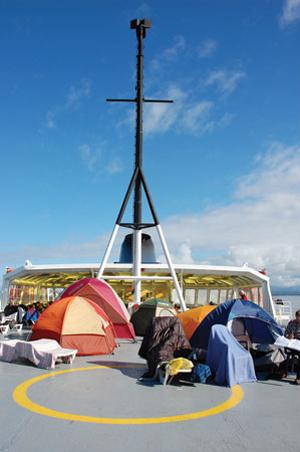
Here’s a picture of campers who’ve pitched tents on deck behind the solarium. Be sure to bring duct tape or rope to secure your tent to the deck or a railing.
The car deck is closed off when the ferry is underway, thus you cannot sleep in your vehicle.
If you would like a cabin or stateroom, those can be added onto your reservation at an additional cost.
Stateroom and Cabin Types
The type and number of cabins will depend upon the ferry making the sailing. Cabins are available on most of the ships in the fleet and are always configured as bunk beds. They are all single beds, no other configuration is possible. Staterooms are available on the M/Vs COLUMBIA, MALASPINA, MATANUSKA, KENNICOTT and TAKU in the Southeast System, and the M/V TUSTUMENA serving the Southwest/South-central Systems, and are sold as a unit with two, three or four bunks. Most cabins feature private bathroom facilities but are available as Roomettes, with facing seats during the day that are made up to upper and lower bunks at night. These use a “bath down the hall”. Room service or daily makeup of cabins is not available. However, trash is collected daily and fresh linens are available upon request.

A typical Two-Berth Outside Cabin or Stateroom on most of the ships provides private facilities (toilet, shower and sink) and a view!
2 Berth roomette with window - Limited space, facing seats make into upper and lower beds for sleeping, no linen and no sink (Pictures shown below)

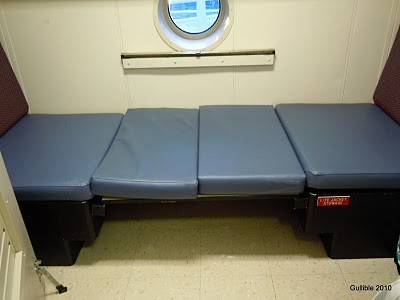
2 Berth no facilities- 1 bunk bed and a sink (Picture shown below)
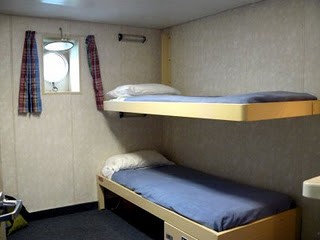
2 Berth full facilities- 1 bunk bed, sink, shower, and a toilet
3 Berth- 1 bunk bed, 1 folding bed or couch, sink, shower, and a toilet (Picture shown below)

4 Berth- 2 sets of bunk beds, sink, shower, and a toilet (Bathroom shown below)
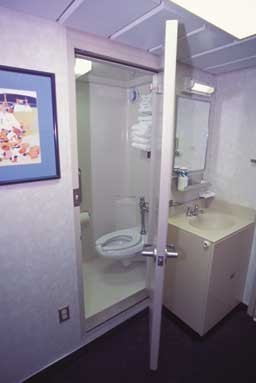
4 Berth Cabins are also available with a sitting room with table and chairs - 2 sets of bunk beds, sink, shower & toilet. Some of these 4 Berth Staterooms are available with an additional space called a “sitting-room”, equipped with a table and chairs. These almost double the space in the cabin.
Dining
All ferries except the M/V Litua serving Metlakatla have a cafeteria. The M/V Tustumena and the M/V Columbia also have a full-service dining room. The cafeteria and dining room are open three times a day during meal times. While there are food options aboard, you are welcome to bring food aboard the ferry. It typically costs us, medium to light eaters, $10-15 per person when we eat at the cafeteria. There’s a salad bar, cereals, fruit bar, snacks, and several main dish options such as Alaskan seafood, sandwiches, burgers, and several soup options. Cash and credit cards are welcome aboard the ferry.
Pets
If you would like to bring a pet they will have to remain on the car deck in a suitable animal carrier or within the vehicle. Various types are acceptable as long as it contains the pet for an extended period of time. You are given the chance to tend to pets during car deck call times, typically every six hours and when the ferry is in port. Certain small birds may be at risk due to car deck temperatures, thus may receive prior approval to be above deck. If this is the case a damage deposit and other restrictions may apply.
Should you want to take the pet into another state or across the border you must have a certificate of health including rabies vaccination valid within 30 days of travel. Pets traveling within Alaska travel free and do not need a health certificate. Pets traveling into Alaska or out of state are charged nominal fees. You can check for current prices on our Fare Calculator.
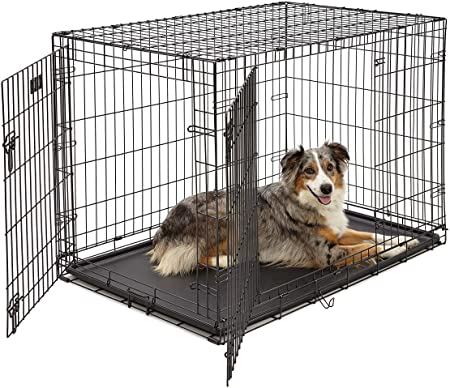
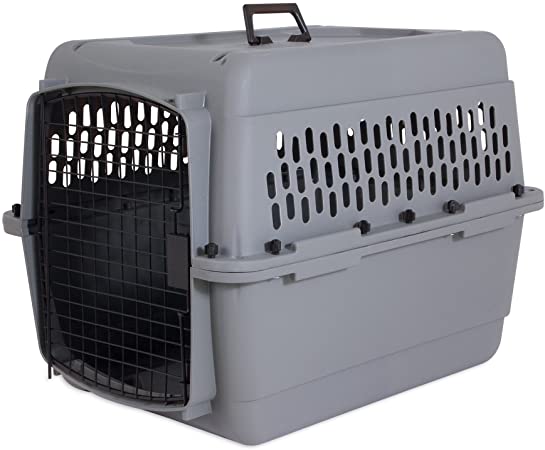
Entertainment
On longer sailings the crew on the ferry will show 2-3 movies a day, ranging from slightly new to older, or documentaries of Alaska and the outdoors. Ask the Purser for more information and the schedule.
The ferries do not have wireless internet access, but they do have outlets to charge electronics. However, electrical current on board AMHS vessels is 110-volt 60-cycle AC and is unprotected from surges and brownouts. Use of personal computers is not recommended unless you have a UPS unit to protect your equipment. Wireless access via Cell data may be available as the ship passes communities along the way.
The ferries have a forward observation lounge. Some have a small play area for children. The ferries have closed their cocktail lounges and gift shops and now serve beer and wine by the glass from the cafeteria for consumption in designated areas. Alcohol may be brought aboard and consumed in staterooms by persons 21 years of age and older. Alcohol may not be consumed in public areas of the ship, including the solarium. Some of the ferries also have a small video game arcade, reading rooms, and card rooms.

An Observation Lounge with airline-type recliner seating
General Restrictions
Alaska law is very specific about smoking in public facilities and that includes State Ferries. Smoking is restricted to the outside decks and posted areas only. The State reserves the right to refuse passage to any person apparently under the influence of drugs or alcohol, or any person whose conduct would be considered dangerous or objectionable to other passengers. Any person, who attempts to gain passage in a fraudulent manner, or any vehicle in an unsafe condition, will be denied boarding.
Telephone Service
Satellite telephone service is available for emergency use only. In addition, Satellite pay-phones are available on some vessels but should not be relied upon due to the mountainous areas in which the ferries operate. Cell phones have limited use except when near communities on the route. Caution should be used as International charges may apply depending on your mobile plan. Electrical current on board is 110-volt, 60-cycle AC. Power is unprotected from surges and brownouts.
Refrigerated Storage
There is no refrigerated storage on board for passengers' commodities although ice is available on most long-haul vessels.
Medical Services
Each vessel has the ability to provide basic emergency medical service with personnel trained at the Emergency Medical Technician (EMT) level. In the event of a medical emergency the ship’s crew will determine the best course of action and direct the vessel to the closest port where medical facilities or services are available. AMHS vessels do not carry ship’s doctors.
Vehicles
The Alaska Marine Highway does not provide for loading or off-loading of vehicles. It is the shipper's responsibility to provide for the loading and off loading of vehicles.
Vehicle Information
Long Overhangs
Drivers of vehicles with long overhangs are advised that due to the large tidal ranges, the angle of the transfer ramp may cause damage to undercarriage units, such as holding tanks or plumbing. Vehicles longer than 25 feet may experience high centering at the top of the transfer bridge at low tide level. The State of Alaska will not be responsible for these types of damage claims.
Construction/Freight Vehicles
Construction vehicles, and/or vehicles hauling freight, are required to provide a certified weight slip showing combined overall weight of the tractor, trailer/van and load. Because weigh stations are not always available at the departure port, truckers should obtain a weight slip before leaving the point of origin.
Motorcycles
All motorcycles must be fully secured on the car deck using the appropriate tie-downs. It is the responsibility of the owner to ensure this is completed properly. Rope may be obtained from car deck personnel for lashing purposes but it's generally advisable to bring your own tie-downs. Motorcycles without sidecars or trailers will be charged at the 10 foot vehicle rate. Otherwise, the overall length vehicle rate applies.
Unaccompanied Vehicles
Non-drivable vehicles and vehicles not accompanied by a driver will be assessed a surcharge of $50 to/from Bellingham, $20 to/from Prince Rupert and $10 to/from all other ports. The Marine Highway does not provide loading and unloading services. If the shipper makes no arrangements to load the vehicle, it will not be loaded. If the shipper does not remove the vehicle from the vessel upon arrival, one of the following actions will be taken at the discretion of the State:
- the vehicle will remain on the vessel and the shipper will be charged for additional shipping;
- the vehicle will be removed from the vessel by a commercial towing company at the shipper's expense;
- the Alaska Marine Highway System will remove the vehicle and the shipper will be charged $100 before the vehicle is released.
9 Ways to Avoid Crowds When Visiting Alaska
Brought to you by Ian Leaf
About a million people visit the ports of Alaska annually to join others in the cruising season, so when visiting you might be hit by the inconvenience of crowding within the cities and key places. However, there are many ways you could reschedule your visit to avoid encountering the huge crowds and here are few tips you should consider. Booking an Alaska Ferry Vacation is primary, but…
1. Visit in shoulder season
You might not like the cold winter in Alaska, but visiting during summer when the season peaks you are not likely going to avoid the crowds. To effectively avoid huge crowds, schedule your trip for May or September and you will have the best time spotting wildlife and visiting various sights. Staying away from large ships and big ports is another, so try a trip on the Alaska Ferry to some of the smaller towns.
2. Take the Denali park shuttle
Instead of using a guided bus tour in Denali National Park, which will obviously have many tourists, you could pick a park shuttle that offers you the privacy you need to explore the park. You can explore a wide area within a few hours before taking another shuttle to drive back to your hotel.
3. Hike independently
Group hikes are a thrill and fascinating, but if you are not into moving along with crowds you might want to consider independent hiking. There are many gentle walking trails in national parks and towns that allow you to walk undisturbed to explore the beauty surrounding you at every turn. This is especially the case if you choose Denali National Park, which is ideal for hikers of every skill level.
4. Go for a ride
If you are moving in a crowd and you are looking for a way to have some time with yourself, you have an option of exploring the neighborhoods by foot, car, or taxi. Many roads in Alaska’s port towns are paved, two-lane, and easy to navigate. You will have more private time when you go for this option and another benefit is that it allows you to see more than when you are bundled together in one vessel with other visitors.
5. Avoid the pier
Another thing that contributes to cruise crowds is the regular tendency of passengers sticking within a two or three block radius of a cruise ship dock. Most of them line up to shop, pass time awaiting excursions, or eat. One way to get away from such crowds is confining your stay further inland, something that will not come as a huge challenge to accomplish. Alaska Ferry Vacations feature overnights in the towns along the way, allowing you to experience what other travelers do not, true Alaskan hospitality.
6. A guided wildlife experience
Get the help of experts to choose the right places to visit for wildlife. A guided tour that is exclusively meant to cater for your needs will ensure you are not led to places where you are likely to suffer the inconvenience of having to deal with huge crowds. These tour experts understand the terrain and can tell which places are likely to be crowded at what time. It gives you much more convenience to also ask questions and learn about different species, so also consider this option to not only get the privacy you desire, but to also add the learning aspect to your trip. Most of our Alaska Ferry tours feature small boats and groups for excursions.
7. Stay up for midnight sun
In Alaska, most locals believe they don’t need a lot of sleep in summer, and sometimes they refer to winter as a long night while summer is taken as a long day. You could take advantage of these glorious and strange times to head deep into the Arctic Circle, where you will have more fun and a chance to experience the beauty of the ice-cream colored skies.
8. Take a learning vacation
At Denali Educational Center, you are offered in-depth learning vacations at their various residential campuses, which are just six miles to the south of the park’s entrance. There are many programs that guide visitors and these are done at places you will not find any crowds. Basically, you can enjoy your time yet not get bothered by the possibility of meeting huge crowds.
9. Ride a bike
A bike comes as an alternative to bus tours, and although you will encounter a bit of traffic at some intersections, the experience is worth every cent as you are taken away from the huge crowds into a pleasurable world where you are free to take your own routes.
